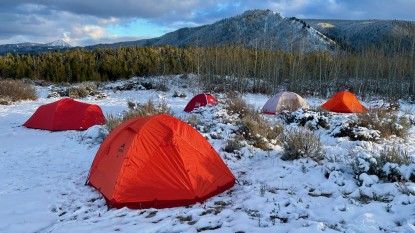MSR Fury Review
Our Verdict
Our Analysis and Test Results
Performance Comparison
Ease of Setup
The inner tent attaches to the outer tent with plastic clips. The MSR Fury was average to slightly above average to set up. It is pretty quick and easy to set up the Fury even in high winds. Some tents, like Hilleberg models, pitch from the outside first, a design that is even faster and easier in all conditions.
Weather Resistance
The pole design priorities headroom over strength in high winds. It resists snow loading well, and we would easily take this tent on most lower 48 adventures. However if you are looking for a Denali or similar style expedition tent we didn't feel the Fury was quite as well designed to survive high winds as The Trango 2, The Mountain 25 or the Hilleberg Tarra. which feature more efficient and effective pole crossings to strengthen the tent. Some other pole designs offer better performance in high winds with only three poles, such as the Hilleberg Jannu. The tent's fabrics are unremarkably average and a far cry from the materials used on Hilleberg, Crux, and SlingFin tents.
Livability
The strength of the Fury is its livability so long as it's not too windy. There's lots of space to sit up, but the walls can blow in your face in windy weather. In high winds we found it to be more comfortable to sleep with our heads toward the entrance because those panels can be pulled tighter and blow in less.
The vestibule is more of a gesture than it is functional. It's tiny and hard to get in and out of compared to all other pole supported vestibules we've tested. Bust out those yoga moves!!
Ventilation is reasonably good in moderate conditions but when you dig the vestibule down and cover the gap between the ground and the outer tent, like you must in foul conditions, ventilation is poor. It's best to put the rear end into the wind because it's smaller and doesn't have the vestibule pole (which is usually the first thing to break on a tent) but when you do that the rear vent needs to be closed to prevent spindrift from entering. Other dome tents, like the Hilleberg Jannu and Hilleberg Tarra offer far superior ventilation in bad weather. Ditto with tunnel tents like the Hilleberg Nammatj.
Durability
Using better fabrics would increase durability and reduce the onset of hydrolysis of the interior PU coating. After not much use we noticed our Fury's
"wetting out" on summertime North Cascade trips.
Weight/Packed Size
Without stakes or guylines the tent weighs 6 lb 2 oz. This is 1oz more than the Hilleberg Jannu, which offers an increase in performance over the Fury. It is lighter than the similarly designed Mountain 25 and Trango 2 but the Fury also isn't as burly.
Adaptability
The MSR Fury was average in adaptability and scored better than single wall tents for below treeline trips but was average to below average on similar trips compared to double wall tents. We felt the Fury just couldn't manage moisture and condensation as well as similarly designed tents. We aren't sure if this is a result of the inner fabric or overall design, but regardless, in rainy and humid temps, where some moisture is expected the Fury had more liquid clinging to the inside of our tent than most others.
Best Application
Winter camping, and most alpine climbs in the lower 48, and light duty big mountain or expedition use.
Value
At $580 the Fury is not a killer deal, the Trango 2 and the North Face Mountain 25 are both less expensive and burlier. The Hilleberg Nammatj 2 retails for only $30 more and is also burlier in stormy conditions and more versatile.!!




